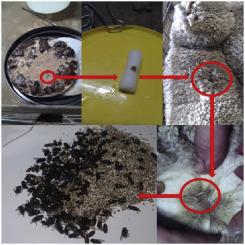International Journal for Parasitology: Drugs and Drug Resistance ( IF 4.1 ) Pub Date : 2020-05-11 , DOI: 10.1016/j.ijpddr.2020.04.005 Narelle Sales 1 , Monica Suann 1 , Kim Koeford 1

|
Late in 2017, field samples of the Australian sheep blowfly, Lucilia cuprina, were submitted by sheep producers from three states of Australia (South Australia, Victoria and New South Wales). Some were collected by submitters concerned about shortened periods of flystrike protection from dicyclanil based products. Neonate larval offspring from the NSW field samples survived and successfully completed their life cycles following exposure to dicyclanil and cyromazine at susceptible discriminating concentrations in vitro. The in vivo study reported here used dicyclanil resistant neonate larvae to assess the flystrike protection provided by a cyromazine jetting fluid and a number of dicyclanil based spray-on products, when applied to sheep six weeks after shearing.
The two dicyclanil resistant blowfly strains used in this study showed in vitro resistance ratios, at the LC50, of approximately 13- and 25-fold relative to a dicyclanil and cyromazine susceptible strain. Compared to the levels of resistance that L. cuprina has developed to other insecticides these are relatively low, however, three dicyclanil based spray–on products (active ingredient 12.5 g/L, 50 g/L and 65 g/L) had protection periods reduced by 73%, 78% and 69% respectively when compared to the maximum protection periods claimed by the manufacturer. A 50% and a 33% reduction in protection period was also observed to a cyromazine and an ivermectin based jetting fluid respectively. In contrast, protection periods were attained or exceeded regardless of the treatment used against field derived dicyclanil susceptible neonate larvae.
For the first time we confirm that dicyclanil resistance enables the completion of the L. cuprina life cycle following flystrike initiation on dicyclanil or cyromazine treated sheep when insecticide levels are considered high and protective. This study also provides in vivo information on the effect of dicyclanil resistance on the protection provided by a product with an active ingredient belonging to an unrelated insecticide group. Dicyclanil resistance is of major concern to the Australian sheep industry.
中文翻译:

澳大利亚羊绿蝇(Lucilia cuprina)对双环苯胺的抗性,大大降低了基于双环苯胺和灭蝇胺的产品对蝇击的保护
2017 年底,澳大利亚三个州(南澳大利亚州、维多利亚州和新南威尔士州)的绵羊生产者提交了澳大利亚绵羊绿蝇( Lucilia cuprina )的现场样本。其中一些是由担心双环苯类产品的飞击保护期限缩短的提交者收集的。来自新南威尔士州野外样本的新生幼虫后代在体外暴露于易受影响的浓度的双环尼和灭蝇胺后存活并成功完成了它们的生命周期。这里报道的体内研究使用双环胺抗性新生幼虫来评估灭蝇胺喷射液和一些基于双环胺的喷雾产品在剪毛后六周应用于绵羊时提供的蝇击保护。
本研究中使用的两种双环胺抗性苍蝇菌株在 LC50 时显示出相对于双环胺和灭蝇胺敏感菌株的体外抗性比率约 13 倍和 25 倍。然而,与铜锈菌对其他杀虫剂产生的抗性水平相比,这些抗性水平相对较低,三种双环苯胺喷雾产品(活性成分 12.5 g/L、50 g/L 和 65 g/L)具有保护期与制造商声称的最长保护期相比,分别减少了73%、78%和69%。还观察到灭蝇胺和伊维菌素基喷射液的保护期分别缩短了 50% 和 33%。相反,无论对田间来源的双环苯胺敏感的新生幼虫采用何种处理,都达到或超过了保护期。
我们首次证实,当杀虫剂水平较高且具有保护性时,双环苯尼抗性能够使经双环苯尼或灭蝇胺处理的绵羊发生飞蝇攻击后完成铜乳杆菌的生命周期。这项研究还提供了关于双环苯胺抗性对含有属于不相关杀虫剂组的活性成分的产品所提供的保护的影响的体内信息。双环苯胺耐药性是澳大利亚绵羊产业的主要关注点。











































 京公网安备 11010802027423号
京公网安备 11010802027423号